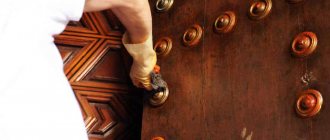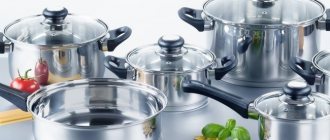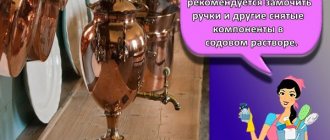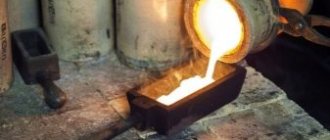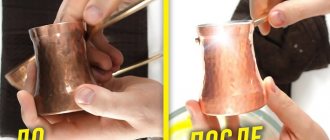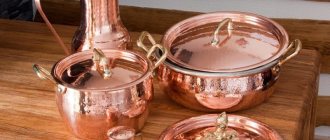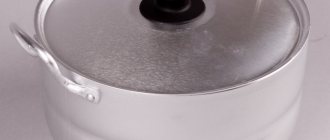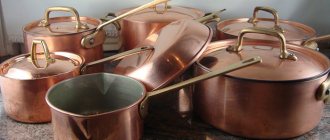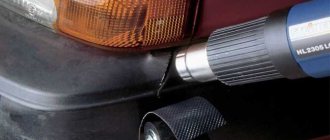People learned to alloy copper with various metals to produce bronze and brass even before our era. This is precisely the reason for their oxidation and the appearance of green and dark spots on the surface, which you constantly have to fight and use different methods to clean the surface. The difference in other components of bronze and brass determines the difference in their characteristics and use in various industries.
What is brass and bronze
Brass refers to alloys of copper and zinc. Different brands of brass contain iron, nickel, manganese, and tin. Previously it was used, mainly due to its light yellow hue, for making jewelry, including fakes, which were passed off as gold items. Characteristics of brass:
- it is ductile, therefore less durable than bronze;
- found application in the manufacture of bimetallic elements;
- resistant to corrosion;
- unstable to aggressive environments (sea water).
Humanity learned to make bronze products several centuries ago, but at that moment it contained only 2 components:
- copper;
- tin.
Brands of bronze with this content are now called tin. In other brands, tin was replaced by aluminum, iron, beryllium, silicon, lead, which is why they are called tin-free. Bronze, due to its special strength, is used to make monuments, bells, candlesticks, and candelabra. Using the fluidity of bronze in the molten state, products of complex configurations are made from it.
Products made of bronze and brass can be distinguished by their fracture. In brass it is light yellow in color and has a fine-grained structure; in bronze it is a darker color with a coarse grain. Bronze consists of only 2 components, and brass can be either 2 components or consisting of several metals.
Determination of steel grade
Steel blanks are made from solid metal solutions based on carbon and iron. Depending on the carbon content, materials are divided into: low-carbon (up to 0.25%), medium-carbon (up to 0.6%), high-carbon (0.6% or more).
Alloying steels with additional materials makes it possible to achieve a higher quality composition with unique properties. The following can be added: titanium, nickel, copper, molybdenum, etc. There are high-alloy steels (from 10%), medium-alloy steels (up to 10%) and low-alloy steels (up to 2.5%).
Typically, steel blanks have markings that allow you to determine the grade and other characteristics of the material by visual inspection. But if there are no such marks, you can use the following methods to obtain the necessary information:
- Carefully cut off the top thin material. We examine the resulting chips for fragility. If it is impossible to cut off a full curl or it is easy to break, then this means that you have high-carbon steel. A material with a low carbon content will produce dense, long chips with a uniform structure that will be easy to cut.
- If you have a stove, you can use a more energy-intensive method. We make a cut on the workpiece, and then expose it to the highest possible temperature. After hardening, we re-cut. If this required little force, as when cutting cold material, then the steel is low carbon.
- We take a grinding wheel and prepare the workplace - we provide good lighting, and set a dark background behind. Our task is to determine the type of steel by the characteristics of the sparks struck. If they are bright and there are a lot of them, then the material is saturated with carbon. In soft low-carbon steels, sparks are dull and their particles are small.
- Using a grinding wheel, you can also identify the metal by the color of the sparks. So, if the shade of the stars is red, then you are dealing with high-carbon steel. A light sheaf with a small amount of sparks indicates that the sample is medium carbon. If the metal is poorly saturated with carbon, it will form straw-colored rays without stars at the ends.
Image No. 2: determining the steel grade by spark
Causes of plaque
The new bronze product has a characteristic golden-brown hue. But gradually this noble color fades, changing to a darker color, and in places becoming covered with a black coating. This occurs as a result of the reaction of metal ions with air molecules and the formation of oxides on the surface of the alloy. The surface film, consisting of copper oxide (CuO) and protecting bronze from further oxidation and corrosion, is called black and noble patina. They prefer not to remove it, believing that such a coating adds mystery, antiquity, and grace to the products.
Another type of patina is green, called wild and causes the destruction of antiques. Appears as a result of prolonged exposure of bronze to a damp room. Hydrogen sulfide and ammonia, which are present in humid air, contribute to the formation of emerald-colored sulfates on the surface of the product. The green coating penetrates deeper and deeper into the composition, causing destructive damage to the object. This type of plaque can be combated using various means, including home remedies.
Cleaning methods
Over several centuries, the population has studied many methods that more or less help clean the surface of bronze products. Among the remedies that help with this problem are:
- flour;
- soda;
- lemon juice;
- table vinegar;
- ammonia;
- finely ground chicory;
- solutions of sulfuric and oxalic acids;
- sawdust;
- school chalk.
During the cleaning process you will also need:
- cotton rag;
- a piece of cloth for polishing;
- container for heating components;
- gloves;
- glasses.
Attention!
Bronze cannot be cleaned once and for all. After cleaning, after some time, plaque appears again, and the procedure is repeated again and again.
Cleaning with food products
Among the food products used to clean bronze are:
- Chicory. Finely ground chicory is diluted in water to a paste. Apply the mixture to a candlestick or other item and rub with a soft brush, preferably a toothbrush. It is convenient for cleaning small and embossed parts. When cleaning, press lightly, without force. The cleaning agent is washed off under running water. Then blot with napkins and dry, wiping with a cotton cloth.
- Peas. A few spoons of peas are placed in a saucepan with water, and a figurine, cigarette case or bronze trinket that needs cleaning is also placed there. Water covers the head of the product. Pea water is boiled for 2-3 hours and cooled. Objects are cleaned of plaque using a soft brush and washed with plenty of water. Then they are thoroughly wiped from moisture.
- Soda and lemon juice. A mixture of baking soda and lemon juice can save bronze from oxidation. Squeeze the juice out of 1-2 lemons and add the same amount of soda to it. The mixture is quickly mixed, applied to the surface that needs to be cleaned and left for 30 minutes. Then the residue is washed off under running water and the surface is wiped dry. This method not only helps get rid of green plaque, but also restores shine.
- Flour, salt and table vinegar. To clean bronze at home, use a mixture of flour and salt. They are taken in equal quantities, diluted with table vinegar to the consistency of sour cream. Apply to the surface to be cleaned, for example, on a bronze chandelier, wait about 30 minutes. The composition is washed off with plenty of water. If the product is poorly cleaned, the procedure is repeated. The dry product is polished with cloth until it shines.
Green copper
Galchiy Proran is a deep ravine that was flooded during the formation of the reservoir. Sprawling poplars and dense bushes once grew around. The interweaving of driftwood at the bottom is all that remains of them. Proran communicates with the Volga and Sviyaga. You won't find a more ideal place to catch predators. That morning the pike struck often. The fry jumping out of the water and the characteristic chomping sound indicated that the perches were also out hunting.
I was in a hurry to catch live bait as quickly as possible. He lowered the feeder, put a worm on the hook of the float rod and began to catch it in the wire. I made a cast, a second one... Without success. I replaced the worm with maggots, but that didn't do anything either. The sun moved confidently across the sky, the splashes of predators were heard less and less often, but I still didn’t have a single live bait, and the zherlits were inactive.
They used dough, bread, steamed oats. The float quickly ran the measured distance, lay down on its side, and everything started all over again. I could clearly see the bottom near the bow of the boat, driftwood with green beards of silky mud. I caught a strand and hung it on a hook. The fish continued to remain indifferent for some time. But near the mud, the ubiquitous fry sparkled with silver droplets. Some fish moved under the snag. I looked closer and saw perches. One of them quickly flew out of cover, grabbed the prey and quickly ducked under a snag.
|
“Should I throw them a spinner?” - a thought flashed. I took out a box in which I could hardly find a single spinner made of once red, but over time, green copper. I re-rigged my fishing rod and slowly lowered the lure into the water. The depth is only twenty centimeters. A shadow darted from under the driftwood. I lifted the rod out of the water with lightning speed. The red-feathered beauty, having described an arc, plopped into the boat.
Things went as well as possible. The perches raced towards the spoon and became my prey. With the excitement, caution was lost. After another cast, the spoon caught on a snag. I had to undress, climb into the water, and then put the boat in a new place. But I caught several perches and was hooked again. To get rid of snags and not lose the only lure, I lit a match and released the hook over the flame.
Moving towards the exit from the hole, I occasionally pulled out large striped predators. Already at the very exit, a nimble little bee was tempted by the spinner. Having bitten the line, he safely went into the depths.
Cleaning with household chemicals
If cleaning with food products does not bring results, use household chemicals. The following are suitable for cleaning bronze at home:
- Ammonia. Ammonia is poured into a small container and the entire product is immersed there for 15 minutes. Then remove with tweezers, rinse thoroughly under running water and wipe dry with rags or napkins.
- Acetone. Use a cotton pad soaked in solvent to wipe the contaminated item, changing them as they become dirty until the cleaning material stops getting dirty. The item is washed with water, dried and polished with cloth.
- Oxalic acid. Used in advanced cases. Dissolve 1.5-2 tablespoons of sorrel in 2 liters of water. Objects are dipped into the solution; when the water turns dark, the objects are removed, washed with plenty of water and wiped dry with napkins.
- Soda Ash. Prepare a solution consisting of 1 liter of water and 20 g of soda. Dip a brush into the solution and wipe off plaque from the product. Thus, you can clean chandeliers, candlesticks, and candelabra that have a large volume. After cleaning, items are washed with water and wiped dry.
Attention!
Before working with aggressive media, you must wear goggles and gloves and, if possible, carry out work under a hood or in the open air.
Unusual methods
People have come up with several unusual methods of combating plaque. You can clean bronze at home using sawdust. Cleaning rules:
- Concentrated acetic acid is poured into a glass container.
- Half the volume is filled with sawdust and the mass is allowed to swell.
- Put a glove on your hand, pick up the swollen sawdust with a cloth and rub the stained areas.
- Constantly change the mixture, throwing away the contaminated one and adding a new one.
- Wash cleaned surfaces with plenty of water and wipe dry.
You can clean bronze at home using toothpaste or powder. Small stains on antique items can be removed with an old toothbrush with toothpowder or toothpaste on it. This method is especially good for finely textured surfaces. The same composition polishes bronze items well.
Cleaning coins using Trilon B
Ancient coins found in your own garden or during construction can be cleaned using Trilon B - used in chemical laboratories for analysis. Procedure:
- Found coins (coins) are first washed from dirt with soap and warm water.
- 1 tbsp. with a slide of Trilon B is dissolved in 200 ml of warm water.
- Place coins in the solution.
- Stir from time to time so that the coins do not stick to each other.
- Cloudiness of the solution indicates the beginning of cleaning from plaque.
- After 40 min. The coins are taken out and washed under water.
- If the products are poorly washed, the procedure is repeated.
- To prevent the coin from rusting in the future, sulfur ointment is rubbed into its surface under running warm water to form a patina that prevents oxidation.
Express cleaning
Cotton pads treated with:
- citric acid, with its help the green patina disappears;
- glacial acetic acid (99%), it dissolves yellow spots;
- 5% ammonia, removes red spots;
- acetone, destroys blackness and dirt.
Attention!
To clean and polish coins at home, GOI paste is also used, which consists of chromium oxide, fatty binders and auxiliary additives. The abrasive paste returns shine to products and removes dark spots on the surface.
Rust removal
All of these methods fight not only green plaque, but also rust of varying degrees. If the depth of the lesion is large, then sulfuric acid and chromium are used against it. Cleaning steps:
- Pour 1 liter of cold water into a glass or ceramic container.
- Add 20 g of potassium dichromate (potassium dichromate) and stir.
- Pour 20 ml of concentrated sulfuric acid over a glass rod and mix.
- Place items that need cleaning.
- After the rust stains are corroded by acid, the objects are removed and immersed in a solution with ammonia, keeping it in it for about 20-30 minutes.
- Antique items are taken out, washed with plenty of water, dried, and rubbed until shiny with cloth.
Rust is removed using pea porridge:
- Yellow peas are boiled to a porridge state.
- Allow to dry completely.
- Remove the dried composition with a rag.
- The product is washed with plenty of water and wiped dry.
Cleaning bronze with gilding
This method is used by jewelers and antique lovers. The cleaning agents they use are aggressive and require careful and attentive handling. Cleaning work should be carried out with gloves and safety glasses. Cleaning steps:
- Bronze is wiped with a solution of KOH or NaOH to degrease and soften plaque.
- Prepare a cleaning composition. Mix 30 parts water, 8 parts nitric acid and 8 parts aluminum sulfate. It is applied to the bronze with a brush and left to dry completely in the sun or near a heat source.
- Wash off the composition with plenty of water, wipe dry and polish.
How to clean bronze from rust at home
If items are corroded, you can return them to their original appearance using food peas.
Instructions:
Boil yellow peas. Without allowing it to cool, grind until the consistency of thick porridge. Apply the paste to the rusty areas and leave to dry. After this, wash the product in boiling water, removing any remaining rust with a brush. Wipe dry on all sides.
Peas are also used if the item is heavily infested with flies.
Instructions:
Boil yellow peas, grind them in the broth with a blender. Dip the contaminated item into the broth and boil for 2 hours. Once cooled, rinse in warm water with a soft brush, removing any remaining peas.
Attention.
To avoid damaging the glossy surface, use pastes and intensive cleaning occasionally, only in cases of severe oxidation. For regular maintenance, simply wipe the items with a damp cloth and then with a dry cloth.
Preventive measures
Cleaning the patina is not enough. To slow down the oxidation processes of bronze after cleaning:
- Rub with wax or paraffin until shiny. These substances leave an invisible film on the surface, which prevents the interaction of metal ions with air oxygen and water vapor.
- Coins are coated with sulfur ointment, which forms a black patina on the surface and prevents oxidation of the surface.
- Particularly valuable ones are placed separately in a piece of velor or suede and placed next to a bag of silica gel to absorb excess moisture.
- Regular cleaning with a flannel cloth reduces the likelihood of patina.
- Small products are periodically cleaned, preventing the appearance of large stains and rust, by dipping them in a soap solution consisting of grated laundry soap and water for 1-3 days, then cleaned with a soft brush. Rinse with water and wipe dry.
Having bronze objects in your home is an expensive pleasure, since they require constant care, but at the same time, the status of the owner as a connoisseur of antiquities and a person of taste increases. If treated with care and properly stored, bronze accessories will last a long time and will provide aesthetic pleasure.
How do you like the article?
Restoration of bronze items
Over time, a corrosive layer forms on the surface, which is called “patina”. The layer is smooth if it is healthy and stable. If it has a powdery spongy structure and contains corrosive moisture agents in direct and constant contact with the metal, then the first restoration consists of removing the peripheral layer of patina for both technical and aesthetic reasons.
For this purpose the following tools must be used:
- micro drills;
- vibro-engravers;
- scalpels;
- scrapers, etc.
The metal is then cleaned with demineralized water with the addition of a neutral detergent. After this you need to start grouting. Anti-corrosion treatment of the product is carried out with pure alcohol.
The second procedure involves the use of two-component resins. They are reinforced by using synthetic fibers suitable for metal expansion. In addition, the method provides excellent results.
